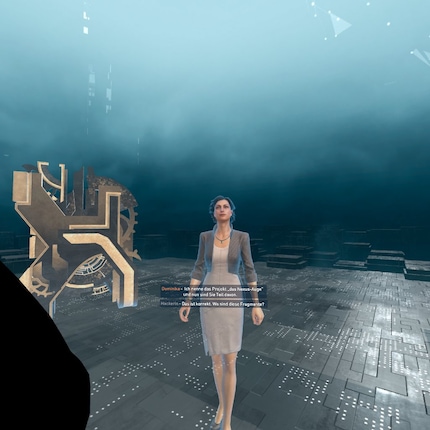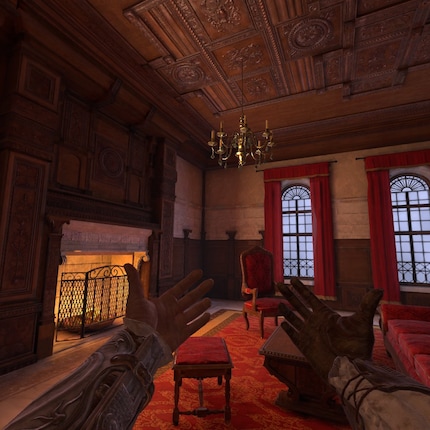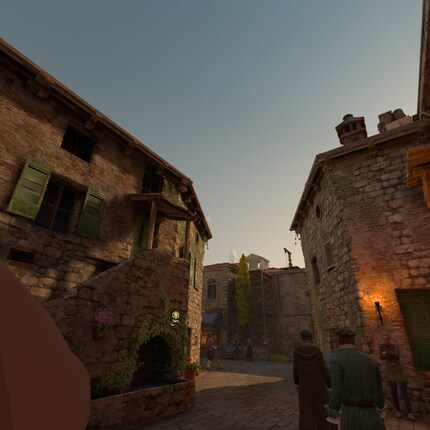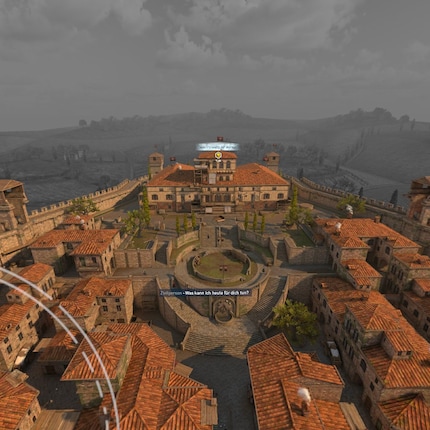

"Assassin's Creed Nexus: Having fun assassinating in virtual reality
The first "Assassin's Creed" for virtual reality glasses is here! I tested the game and really enjoyed it.
Sneaking around in virtual reality as an assassin and immersing myself completely in Ubisoft's beautiful game worlds has been my dream since I first put VR glasses on my nose in 2017. With "Assassin's Creed Nexus" and a Meta Quest 3, this dream is now coming true.
"Asassin's Creed Nexus" is now available for Meta Quest 3, Meta Quest 2 and Meta Quest Pro. I have already been able to spend a few hours in the game. You can get my impression of the controls, the combat system, the graphics and, of course, the storyline here.
You control three well-known assassins
"Nexus" is structured differently to the other parts of the game series. You are a hacker from the Brotherhood of Assassins and work undercover at Abstergo. The Abstergo group is the cover for the machinations of the Knights Templar - the traditional enemy of all Assassins - who want to increase their power at the expense of everyone's freedom. Abstergo has found a new way to achieve its goals. And you are the key person for it.

The complete memories of various assassins are stored in the Abstergo Cloud. This is where the Animus comes into play: this is a virtual environment in which you can relive the memories of important personalities from the past. Most "AC" veterans should be familiar with this concept. In "Nexus", the element of memory simulation as virtual reality is implemented coherently and consistently. For me, the whole Animus story was rather abstract in the last few games, but in a VR game it really makes sense.

Source: Debora Pape
Your task is to enter several important moments in the memories of three well-known assassins from previous games. There you are to find special artefacts for Abstergo and sabotage them - for the Brotherhood. "Assassin's Creed Nexus" is therefore not an open-world game, but a compilation of different missions with different assassins in different locations.
You can play Ezio Auditore da Firenze in Italy around 1500, Cassandra in Ancient Greece and Connor Kenway at the time of the American Revolution around 1800.
In the middle instead of just in front: First appearance in a palazzo
After the introduction, the action starts right away: you open your eyes as Ezio in an Italian palazzo. As always, VR takes my breath away: I find myself in a magnificently furnished bedroom. It's night, through a window I can see fireworks over the rooftops of Venice and hear the murmur of people. As I look down at myself, I realise that I'm wearing Ezio's clothes. Instead of the tip of my own nose, I can see the tip of Ezio's - whose nose size is adjustable, by the way. You can even put the Assassin's hood over your head with the appropriate hand movements.

Source: Debora Pape
The game doesn't throw you in at the deep end. It gives you enough time to interact with objects and familiarise yourself with the controls. As soon as you feel confident, you can really get going. Your first task is to retrieve your sword. A quest marker in the interface shows you where you need to go. This first memory simulation serves as a tutorial to give you at least rudimentary assassin training.
This naturally includes sneaking and killing. Whether you actually crouch down to make yourself small or press a button on the controller instead is up to you. But I can tell you: the life of an assassin in a crouch is pretty exhausting.
The combat system is intuitive and fun
You can distract enemies by throwing objects standing around. Or you can choose the radical method and send them to their ancestors. By pressing the trigger and moving your wrist, the infamous Assassin's Blade will spring forth and you can violently plunge it into unsuspecting guards. Incidentally, no blood flows, the enemies die without visible wounds. Nevertheless, "Nexus" is only authorised for players aged 18 and over.
If you can't do it from behind, you can go for a frontal attack. Use your sword to block your opponent's attacks and take advantage of opportunities to counterattack. It is also possible - but not so easy at first - to strike your opponent's weapon at the right moment and in the right place to interrupt their attack. You can then finish off badly damaged opponents with a quick advance using the Assassin's Blade.
Over the course of the game, you will also unlock various skills and weapons, such as jumping attacks and jostling enemies. The throwing knives you receive find their target almost automatically, so you don't need to aim precisely. However, if you throw completely past your opponent, they will notice you and this can lead to unwanted fights. You can also use the knives to trigger traps, for example a crate hanging from a rope. If you cut the rope, the crate will bury your opponents underneath it.
The fights are great fun. You have to recognise and seize the right moments to take your opponents apart professionally. The developer studio Ubisoft has put a lot of thought into utilising the possibilities of VR for an interesting combat system. It encourages you to execute good combinations like an assassin and take out an opponent quickly and cleanly. Simply hacking at your opponent is also possible, but you run the risk of taking a beating yourself.
Small but fine game environments
After the introductory level, you visit Ezio's hometown of Monteriggioni in Tuscany. You are to visit Ezio's sister Claudia at the family estate. In the lively streets of the picturesque small town, aristocratic ladies stroll around in beaded velvet and silk dresses, craftsmen hammer away at wooden beams, vendors advertise their wares and every now and then a thief runs through the alleyways. In short: the game world feels alive.

Source: Debora Pape
Graphically, of course, the environment cannot compete with an "Assassin's Creed Mirage" from 2023. Up close, the models and textures are more reminiscent of games from 2010 - but standalone VR glasses are not a next-gen console either. The main feature of VR games is immersion and Ubisoft has done a great job here.
There is an invisible wall around the city that you can't get past. Instead, Monteriggioni is largely open to you, and after you have synchronised with the Animus at the highest point, various side activities are displayed. Synchronising and, above all, the subsequent death jump into the obligatory haystack is a must in any Assassin's Creed game. Virtual reality naturally provides a special thrill when jumping from a height.
The Animus scout is available to help you find your way around the city: When activated, you appear to hover over a lifelike model of the city while people continue to walk the streets. Perhaps Ubisoft has taken inspiration here from "Google Earth VR", which feels similarly fascinating.

Source: Debora Pape
There's a lot to do in the story missions
Wandering around the city is quite nice, but it gets really interesting in the story mission in the family estate. You get more to do there: You talk to your sister, eavesdrop on conversations, search for items and assemble objects. Sneaking, assassinations and fights are of course also part of the game.
In parts, you can move more or less freely in the mission area and in others you follow a predetermined course path in which you climb, jump and swing in classic AC style.
In addition, Ubisoft has hidden several collectables, such as historical background information. So it's worth keeping your eyes and ears open. When leaving the mission, there is a summary and I realised that I had overlooked almost all of the collectables.
What about motion sickness and fear of heights?
Motion sickness is a well-known problem in VR games: many people feel uncomfortable when moving around in VR games. Nexus offers various comfort settings for this. These include the choice between free movement and teleport function, tunnel vision when turning and moving and - depending on the setting - a reminder every 15 minutes to take a break before your stomach rebels. With the teleport function, you can let your character "hop" from place to place instead of moving continuously.
I chose a middle ground for the comfort settings. Immersion is very important to me. However, this comes at a price: after half an hour at the latest, I notice a slight discomfort and have to take a break. Movement in VR games is simply a problem (for me). Accordingly, I also have no increased interest in the course challenges that are offered in the free game environments.
In "Assassin's Creed", climbing on building facades and over roofs is also part of the game. Those with a fear of heights can have lines simulating the ground displayed to minimise the feeling of great heights.
Virtual reality is also great fun as an assassin!
Although I've only seen a small part of the game, I can already say that it's really fun. The realisation with different assassins in different locations is coherent with VR and impressively shows the possibility of virtual reality to take the player to otherwise inaccessible places.
I'm not yet in a position to judge whether the game will develop an exciting story as it progresses or whether it will rely too much on repetition. Overall, "Assassin's Creed Nexus" should keep you busy for around 15 to 20 hours. There is nothing to criticise about the game's performance. I played it directly on the Quest 3 and didn't experience any stutters or crashes.
Compared to current games that you play on the screen, the action options, for example riding horses or talking to NPCs, are more limited. As a result, freely exploring the game environment is less challenging. However, the immersion makes up for this. The real action also comes in the mission environments.
I think that Ubisoft has made a very good case for virtual reality with "Nexus", similar to "Half Life: Alyx" from Valve, for example. If the game is also financially successful, I hope that other major game developers will take heart and realise VR versions for their popular game series.
Header image: Ubisoft
Feels just as comfortable in front of a gaming PC as she does in a hammock in the garden. Likes the Roman Empire, container ships and science fiction books. Focuses mostly on unearthing news stories about IT and smart products.
Which films, shows, books, games or board games are genuinely great? Recommendations from our personal experience.
Show all

